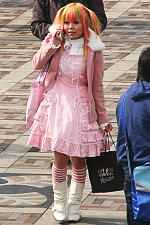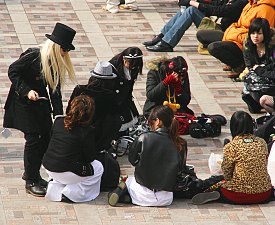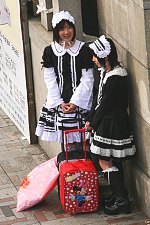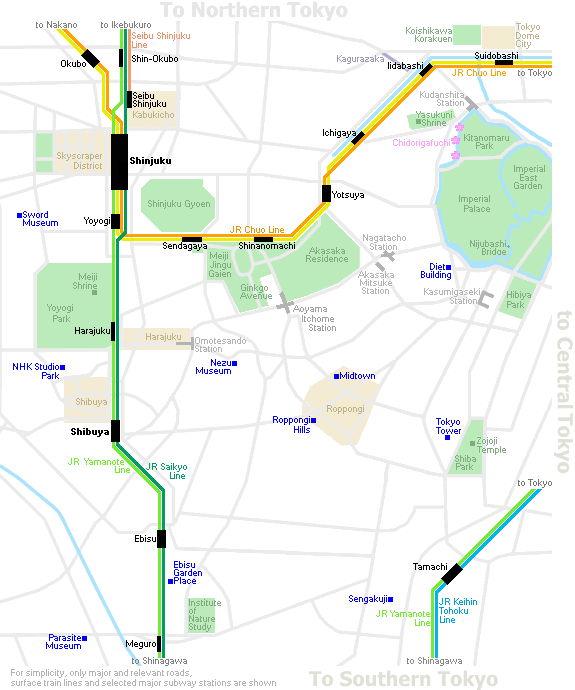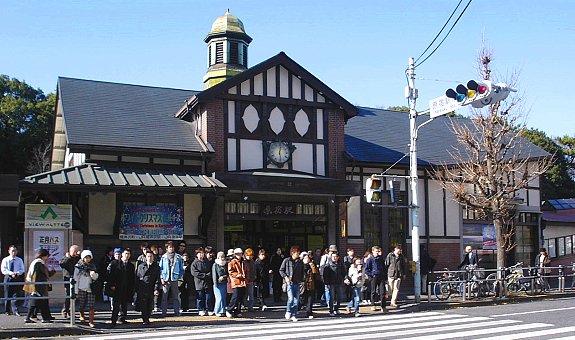 Harajuku Station
Harajuku Station
Harajuku (原宿) refers to the area around Tokyo's Harajuku Station, which is between Shinjuku and Shibuya on theYamanote Line. It is the center of Japan's most extreme teenage cultures and fashion styles, but also offers shopping for adults and some historic sights.
The focal point of Harajuku's teenage culture is Takeshita Dori (Takeshita Street) and its side streets, which are lined by many trendy shops, fashion boutiques, used clothes stores, crepe stands and fast food outlets geared towards the fashion and trend conscious teens.
In order to experience the teenage culture at its most extreme, visit Harajuku on a Sunday, when many young people gather around Harajuku Station and engage in cosplay ("costume play"), dressed up in excentric costumes to resemble anime characters, punk musicians, etc.
A variety of fashion styles on display at Harajuku on a Sunday
Just south of Takeshita Dori and over twice its length is Omotesando, a broad, tree lined avenue sometimes referred to as Tokyo's Champs-Elysees. Here you can find famous brand name shops, cafes and restaurants for a more adult clientele. The stylish Omotesando Hills complex was opened in 2006 and targets fashion conscious urbanites in their 30s and 40s, while Kiddy Land has hundreds of unique toys for kids of all ages.
Harajuku is not only about teenage culture and shopping. Meiji Jingu, one of Tokyo's major shrines, is located just west of the railway tracks in a large green oasis shared with the spacious Yoyogi Park. Beautiful ukiyo-e paintings are exhibited in the small Ota Memorial Museum of Art, and the Nezu Museum has an impressive collection of various Asian art as well as a traditional Japanese garden.
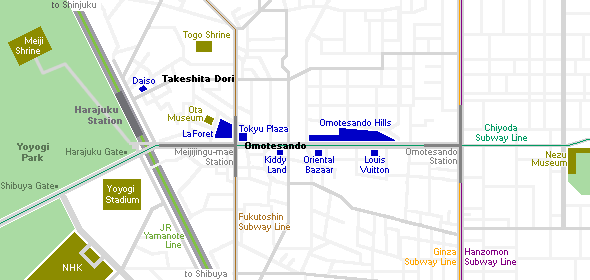
Famous Streets
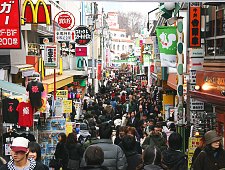 |
| Takeshita Dori |
| Shops along Takeshita Dori tend to be open daily from 11:00 to 20:00. |
| The symbol of Harajuku and birthplace of many of Japan's fashion trends, Takeshita Dori (Takeshita Street) is a narrow, roughly 400 meter long street lined by shops, boutiques, cafes and fast food outlets targetingTokyo's teenagers. Because of the street's popularity, it becomes extremely busy and crowded on the weekends. Interesting shops and restaurants can also be found along some of the side streets. |
|
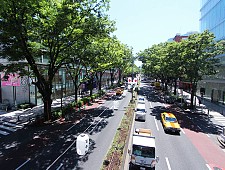 |
| Omotesando |
| Shops along Omotesando tend to be open daily from 11:00 to 20:00. |
| Referred to as Tokyo's Champs-Elysees, Omotesando is a one kilometer long, tree lined avenue, serving as the main approach to Meiji Shrine. Numerous stores, boutiques, cafes and restaurants, including several leading fashion brand shops, stand along the avenue. This area generally caters to an older and wealthier clientele than Takeshita Dori. |
|
Shopping
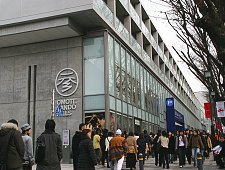 |
| Omotesando Hills |
Shops: 11:00 to 21:00 (Sundays until 20:00)
Restaurants: 11:00 to 23:30 (Sundays until 22:30). |
| Opened in 2006, Omotesando Hills consists of six floors (three are underground) of about 100 upmarket shops, cafes, restaurants and beauty salons. The building was designed by the renowned architect Ando Tadao and has intriguing design elements. The shopping complex isOmotesando's most prominent establishment, stretching along about one quarter of the avenue. Apartments are located above the shops. |
|
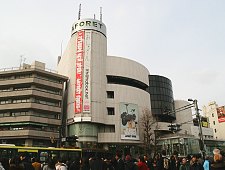 |
| LaForet Harajuku |
| Open daily from 11:00 to 20:00 |
| LaForet Harajuku is a trend setting shopping complex, consisting of seven floors of fashion boutiques and shops, mainly geared towards a young, female audience. The LaForet Museum on the top floor hosts various events and exhibitions. |
|
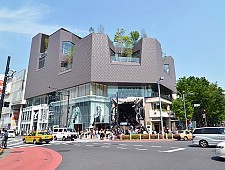 |
| Tokyu Plaza Omotesando Harajuku |
Shops: 11:00 to 21:00
Restaurants: 8:30 to 23:00 |
| Opened in April 2012, this is one of the newest additions to the district. The interestingly designed building houses multiple floors of fashion and lifestyle shops, as well as a pleasant green space on a terrace on the 6th floor. |
|
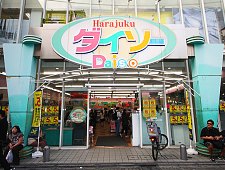 |
| Daiso Harajuku - 100 Yen Shop |
| Open daily from 10:00 to 21:00 |
| This is one of the largest 100 Yen Shops in central Tokyo, offering a wide array of goods, including clothing, kitchenware, food and stationery on multiple floors at 105 yen per item. It is located only a few steps from Harajuku Station along Takeshita Dori. |
|
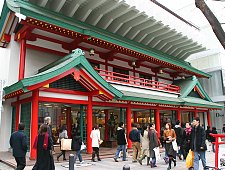 |
| Oriental Bazaar |
10:00 to 19:00
Closed: Thursdays |
| This is one of Tokyo's largest souvenir shops, very popular among foreign travelers in search of typical Japanese souvenirs, such as kimono, tableware, lamps, dolls, furniture and samurai related goods. The shop spans three floors and has a red and green facade that mimics traditional Japanese architecture. Travelers who pass by the store front are sure to notice the building. |
|
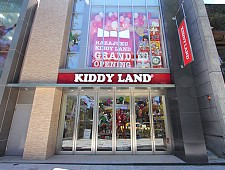 |
| Kiddy Land |
| 11:00 to 21:00 (from 10:30 on weekend and national holidays) |
| One of Tokyo's most famous and popular toy stores, Kiddy Land has a fantastic selection of toys and other products to amuse kids, including a Snoopy Town and Hello Kitty Shop on a total of five floors. The Omotesando store was reopened in July 2012 after being reconstructed and redesigned. |
|
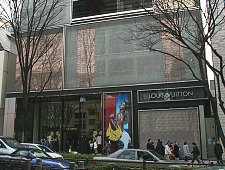 |
| Louis Vuitton |
| Open daily from 11:00 to 20:00 |
| The Louis Vuitton Omotesando store was opened in autumn 2002 as the company's largest store. It is one of many famous brand names that have opened a store along Omotesando. The public store makes up five of the building's ten floors, which are designed as a stack of trunks rather than conventional floors. |
|
Other Attractions
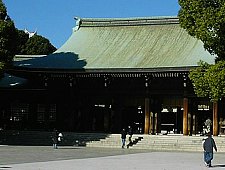 |
| Meiji Shrine (more information) |
Sunrise to sunset
Closed: No closing days
Admission: Free |
| Meiji Shrine (Meiji Jingu) is a Shinto shrine dedicated to the deified spirits of Emperor Meiji and his consort, Empress Shoken. Emperor Meiji was a popular emperor who reigned from 1867 to 1912. The majority of the shrine grounds are composed of a beautiful, dense forest that can be explored on walking paths. |
|
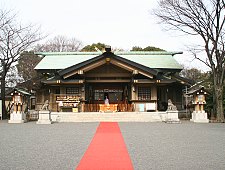 |
| Togo Shrine |
Closed: No closing days
Admission: Free |
| Togo Shrine is a Shinto shrine dedicated to Admiral Togo, who defeated the Russian fleet in the Russo-Japanese War in 1905. The Togo Antique Market was held around the shrine on the first Sunday of each month, but it was discontinued in December of 2009. |
|
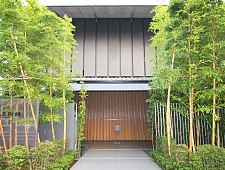 |
| Nezu Museum |
10:00 to 17:00 (entry until 16:30)
Closed: Mondays (or next day if Monday is a national holiday), New Year
Admission: 1000 yen (or 1200 yen for special exhibition) |
| The Nezu Museum has a collection of East Asian artwork that includes various objects from Japan, China and Korea. The museum building and exhibition rooms have a simple and elegant design and there is a large traditional Japanese garden outside the building that can be explored. |
|
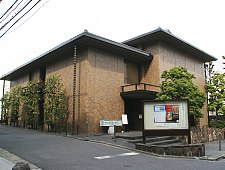 |
| Ota Memorial Museum of Art |
10:30 to 17:30 (entry until 17:00)
Closed: Mondays (or following day if Mon is a national holiday), New Year holidays, a few days at the end of each month
Admission: Typically 700 yen, may vary according to exhibition |
| The small and elegant Ota Memorial Museum of Art exhibits selectedukiyo-e paintings and prints from the vast collection of the late Mr. Ota Seizo, which comprises of more than 10,000 pieces of art. Exhibits are changed every month. |
|
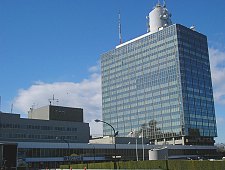 |
| NHK Studio Park (more details) |
| Please see the NHK Studio Park page for details on hours and admission. |
| NHK Studio Park is a part of the NHK Broadcasting Center, which is open to the public. It gives visitors a chance to look behind the scenes of television broadcasting, including the production of a live program on most days. |
|
 |
| Yoyogi Park |
5:00 to 20:00 (until 17:00 during the winter)
Facilities are typically open from 9:00 to 17:00. |
| Yoyogi Koen (Yoyogi Park) is one of Tokyo's largest and most pleasant cityparks, featuring wide lawns, ponds and forested areas. It is a great place for jogging, picnicking and other outdoor activities. |
|
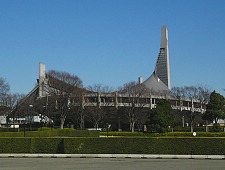 |
| National Yoyogi Stadium |
| Built for the 1964 Tokyo Olympics by renowned architect Tange Kenzo, the stadium hosted the olympic swimming competitions. It is now also being used for ice skating and volleyball competitions, concerts and various other events. |
|
|


